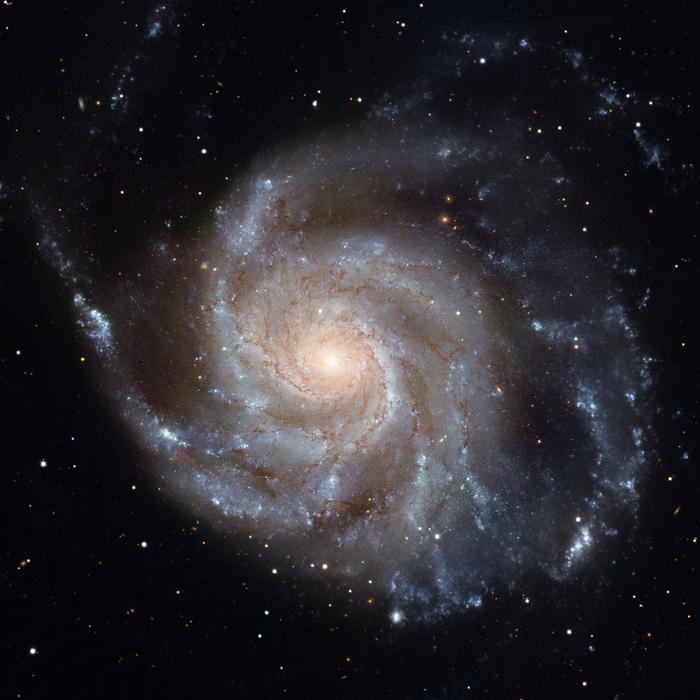A nearby supernova in 2023 offered astrophysicists an excellent opportunity to test ideas about how these types of explosions boost particles, called cosmic rays, to near light-speed. But surprisingly, NASA’s Fermi Gamma-ray Space Telescope detected none of the high-energy gamma-ray light those particles should produce.

Credit: NASA, ESA, CXC, SSC, and STScI
A nearby supernova in 2023 offered astrophysicists an excellent opportunity to test ideas about how these types of explosions boost particles, called cosmic rays, to near light-speed. But surprisingly, NASA’s Fermi Gamma-ray Space Telescope detected none of the high-energy gamma-ray light those particles should produce.
On May 18, 2023, a supernova erupted in the nearby Pinwheel galaxy (Messier 101), located about 22 million light-years away in the constellation Ursa Major. The event, named SN 2023ixf, is the most luminous nearby supernova discovered since Fermi launched in 2008.
“Astrophysicists previously estimated that supernovae convert about 10% of their total energy into cosmic ray acceleration,” said Guillem Martí-Devesa, a researcher at the University of Trieste in Italy. “But we have never observed this process directly. With the new observations of SN 2023ixf, our calculations result in an energy conversion as low as 1% within a few days after the explosion. This doesn’t rule out supernovae as cosmic ray factories, but it does mean we have more to learn about their production.”
The paper, led by Martí-Devesa while at the University of Innsbruck in Austria, will appear in a future edition of Astronomy and Astrophysics.
Trillions of trillions of cosmic rays collide with Earth’s atmosphere every day. Roughly 90% of them are hydrogen nuclei – or protons – and the remainder are electrons or the nuclei of heavier elements.
Scientists have been investigating cosmic ray origins since the early 1900s, but the particles can’t be traced back to their sources. Because they’re electrically charged, cosmic rays change course as they travel to Earth thanks to magnetic fields they encounter.
“Gamma rays, however, travel directly to us,” said Elizabeth Hays, the Fermi project scientist at NASA’s Goddard Space Flight Center in Greenbelt, Maryland. “Cosmic rays produce gamma rays when they interact with matter in their environment. Fermi is the most sensitive gamma-ray telescope in orbit, so when it doesn’t detect an expected signal, scientists must explain the absence. Solving that mystery will build a more accurate picture of cosmic ray origins.”
Astrophysicists have long suspected supernovae of being top cosmic ray contributors.
These explosions occur when a star at least eight times the Sun’s mass runs out of fuel. The core collapses and then rebounds, propelling a shock wave outward through the star. The shock wave accelerates particles, creating cosmic rays. When cosmic rays collide with other matter and light surrounding the star, they generate gamma rays.
Supernovae greatly impact a galaxy’s interstellar environment. Their blast waves and expanding cloud of debris may persist for more than 50,000 years. In 2013, Fermi measurements showed that supernova remnants in our own Milky Way galaxy were accelerating cosmic rays, which generated gamma-ray light when they struck interstellar matter. But astronomers say the remnants aren’t producing enough high-energy particles to match scientists’ measurements on Earth.
One theory proposes that supernovae may accelerate the most energetic cosmic rays in our galaxy in the first few days and weeks after the initial explosion.
But supernovae are rare, occurring only a few times a century in a galaxy like the Milky Way. Out to distances of around 32 million light-years, a supernova occurs, on average, just once a year.
After a month of observations, starting when visible light telescopes first saw SN 2023ixf, Fermi had not detected gamma rays.
“Unfortunately, seeing no gamma rays doesn’t mean there are no cosmic rays,” said co-author Matthieu Renaud, an astrophysicist at the Montpellier Universe and Particles Laboratory, part of the National Center for Scientific Research in France. “We have to go through all the underlying hypotheses regarding acceleration mechanisms and environmental conditions in order to convert the absence of gamma rays into an upper limit for cosmic ray production.”
The researchers propose a few scenarios that may have affected Fermi’s ability to see gamma rays from the event, like the way the explosion distributed debris and the density of material surrounding the star.
Fermi’s observations provide the first opportunity to study conditions right after the supernova explosion. Additional observations of SN 2023ixf at other wavelengths, new simulations and models based on this event, and future studies of other young supernovae will help astronomers home in on the mysterious sources of the universe’s cosmic rays.
Fermi is an astrophysics and particle physics partnership managed by Goddard. Fermi was developed in collaboration with the U.S. Department of Energy, with important contributions from academic institutions and partners in France, Germany, Italy, Japan, Sweden, and the United States.
DOI
10.1051/0004-6361/202349061
Article Title
Early-time gamma-ray constraints on cosmic-ray acceleration in the core-collapse SN 2023ixf with the Fermi Large Area Telescope
Article Publication Date
16-Apr-2024




